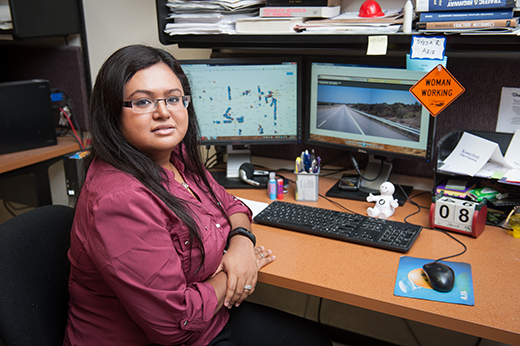Kansas State University researcher develops crash prediction model for rural highways
Wednesday, April 13, 2016

Syeda Rubaiyat Aziz, doctoral candidate in civil engineering at Kansas State University, is partnering with the Kansas Department of Transportation to develop a state-specific crash prediction model for rural multilane highways.| Download this photo.
MANHATTAN — A Kansas State University researcher is partnering with the Kansas Department of Transportation, or KDOT, to develop a state-specific crash prediction model for rural multilane highways.
"Saving even a single life would be important for Kansas as well as for the United States," said Syeda Rubaiyat Aziz, doctoral candidate in civil engineering, Bangladesh.
For her research, Aziz started with calibrating the American Association of State Highway and Transport Officials' Highway Safety Manual methodology. She is using Google Maps and KDOT video logs to examine each roadway segment and intersection for obtaining number of crashes and a variety of other factors, including the presence of lighting posts, driveway density and roadside hazard rating. The roadway geometric data were provided by KDOT, which is funding the research project.
Additionally, Aziz has developed a new Kansas-specific crash prediction tool. Her research indicates that this model performs better than existing High Safety Manual in predicting crashes in Kansas.
Aziz categorizes crashes into three severity levels: fatal crashes, injury crashes and property damage-only crashes. She further divides injury crashes into three subcategories: incapacitating, non-incapacitating and possible injuries.
Aziz foresees a two-step use for her research results. First, her findings are useful in identifying the most hazardous or unsafe segments and intersections of rural roadways. Then, the conclusions can direct in finding suitable countermeasures and thereby prioritizing requests within the state's transportation budget.
Aziz's faculty mentor, Sunanda Dissanayake, professor of civil engineering, said the practicality and applicability of Aziz's research makes it relevant to a variety of stakeholders, from legislators and planners to anyone who drives on country roads.
"Rural highway safety is a critical issue in Kansas, and the number of fatalities due to motor-vehicle crash involvement is considerable," Dissanayake said. "Finding ways to save lives will bring enormous benefits at all fronts."
Aziz plans to complete the KDOT-funded project and obtain her doctoral degree in May. Upon completion, KDOT will use Aziz's research findings and readjust the model to current data for future projects.
"It is imperative that the model be updated on schedule so that the future crash predictions would be as accurate as possible," Aziz said. "When you get out on the roads and the conditions are unsafe, you can't have peace of mind. My research will give the people of Kansas a better quality of life."
In February, Aziz presented her research at the 13th Capitol Graduate Research Summit in Topeka.
